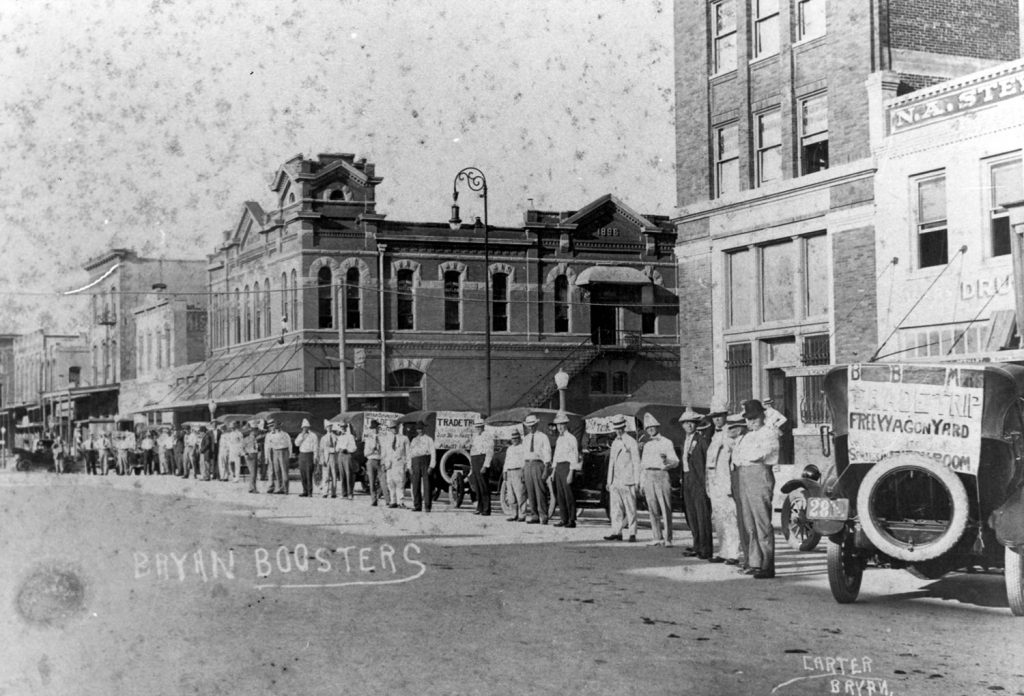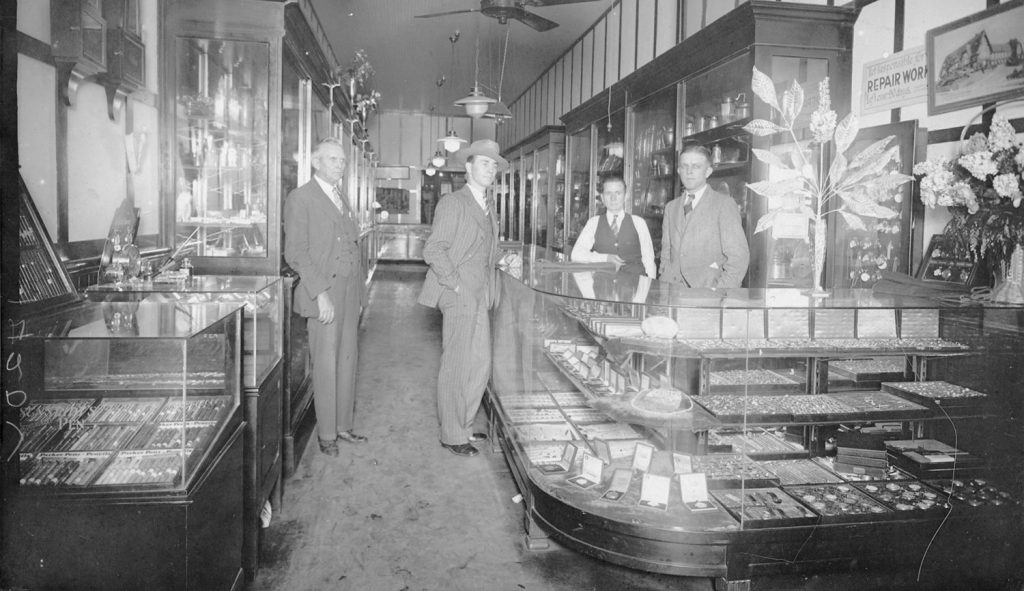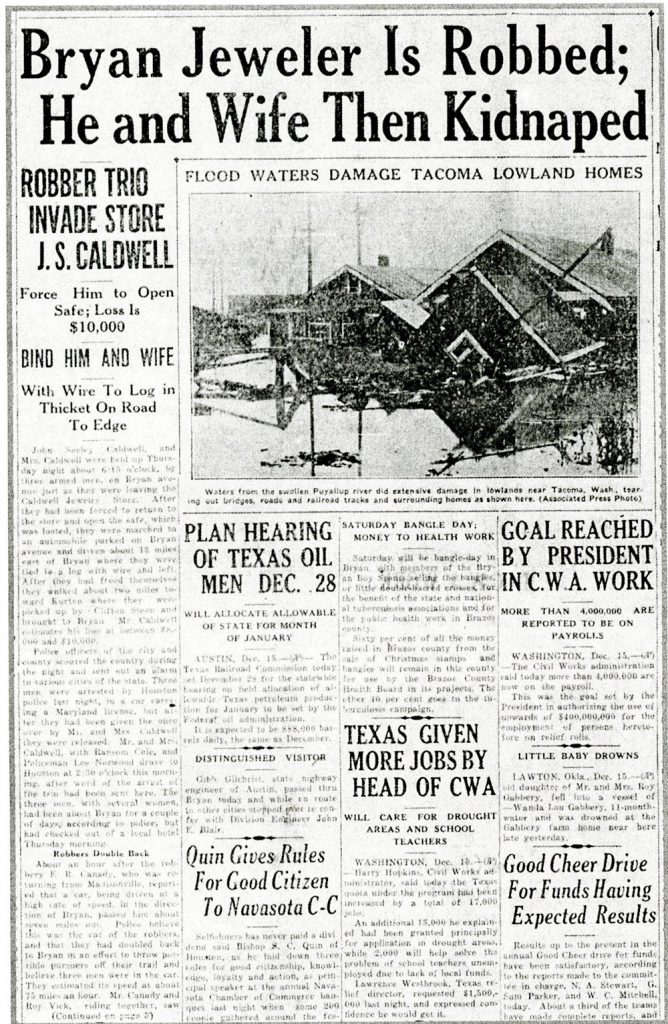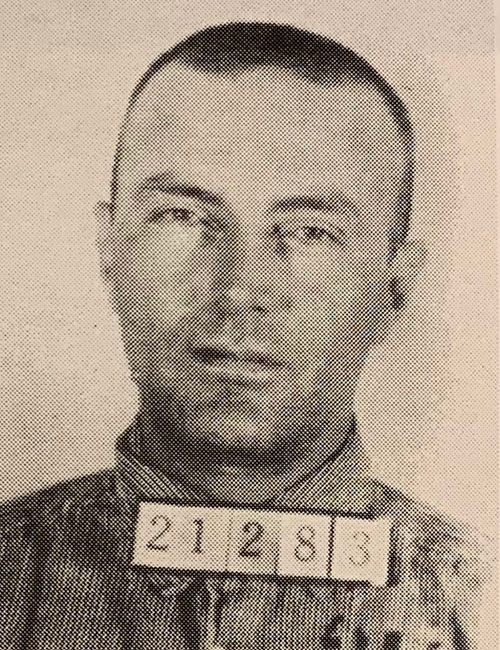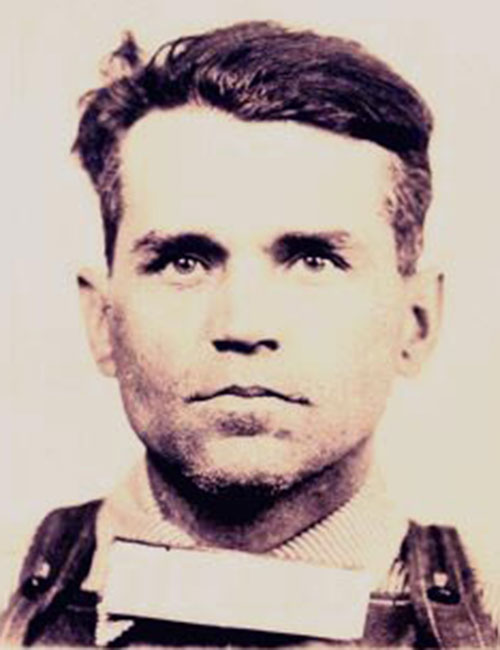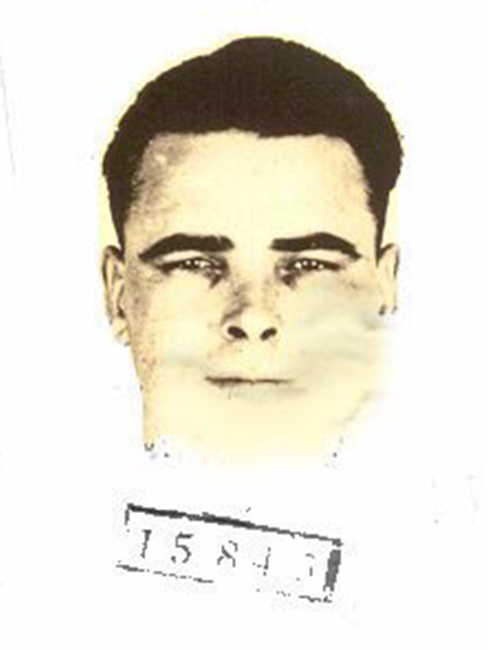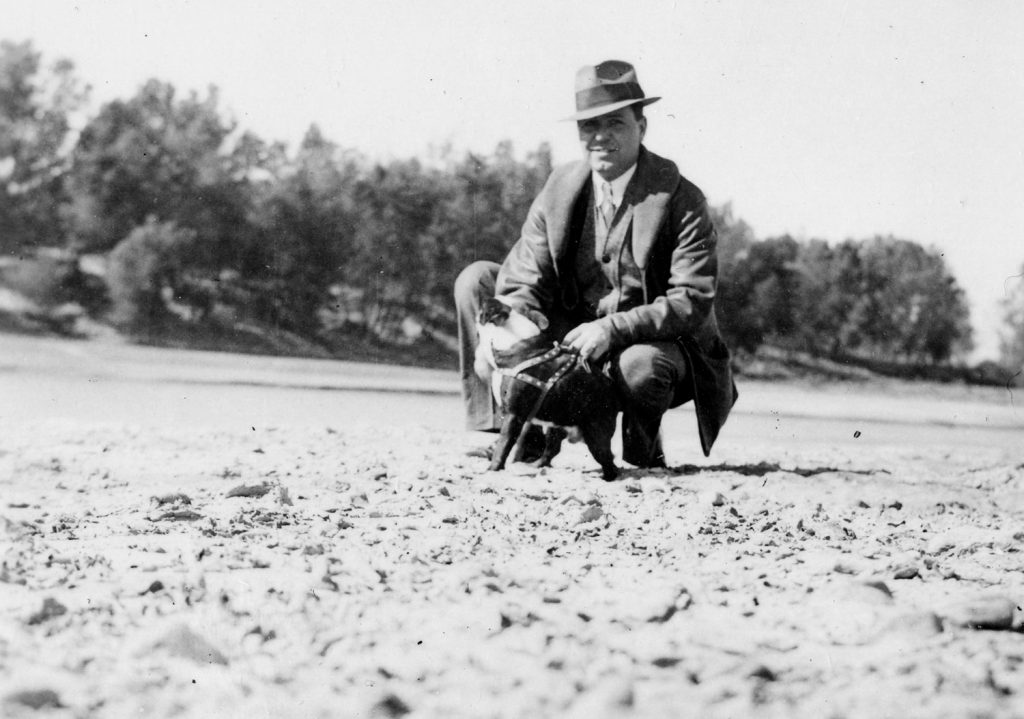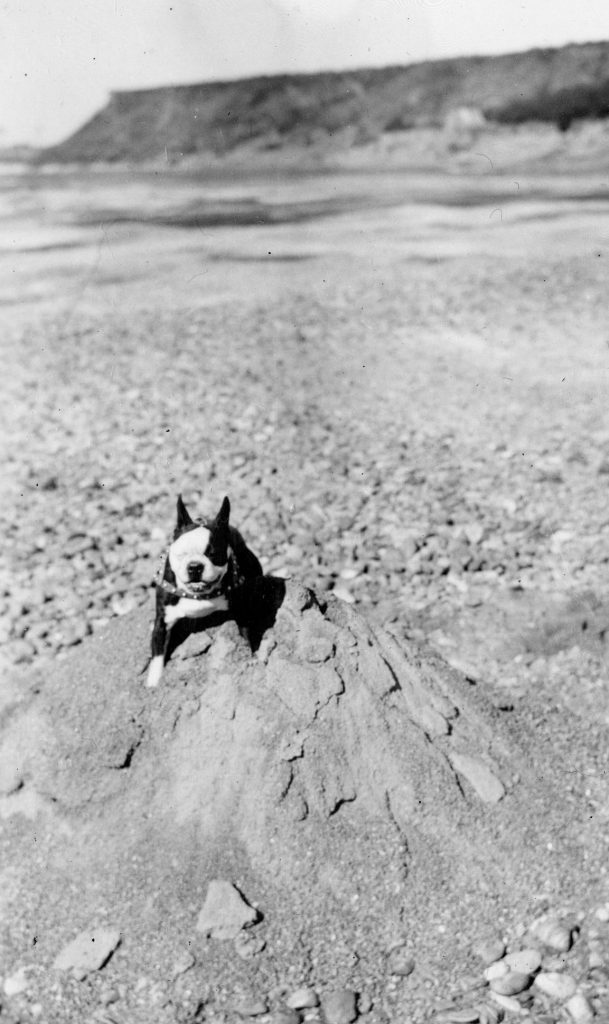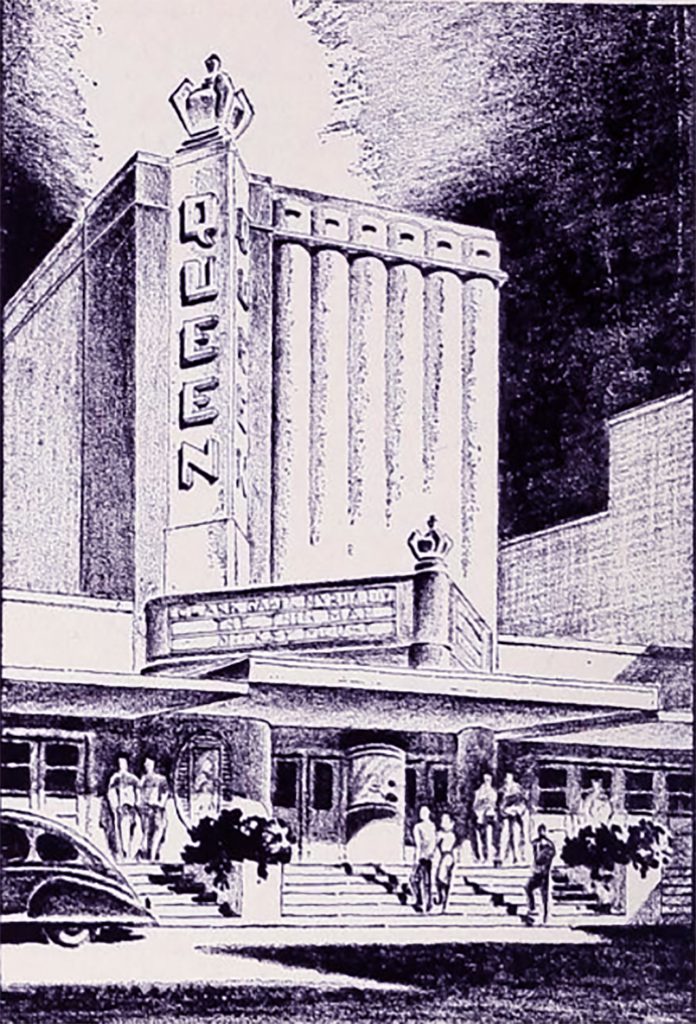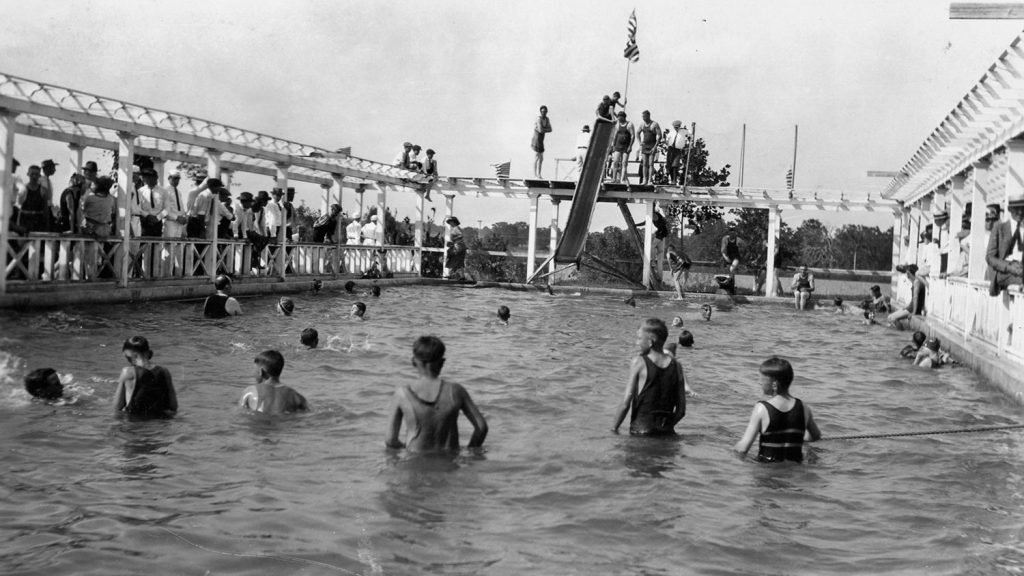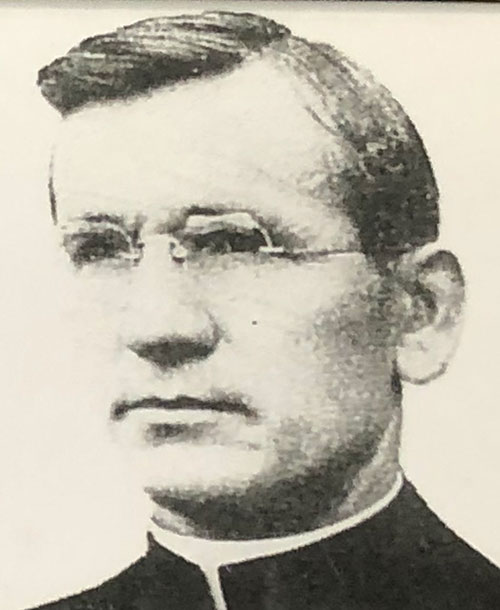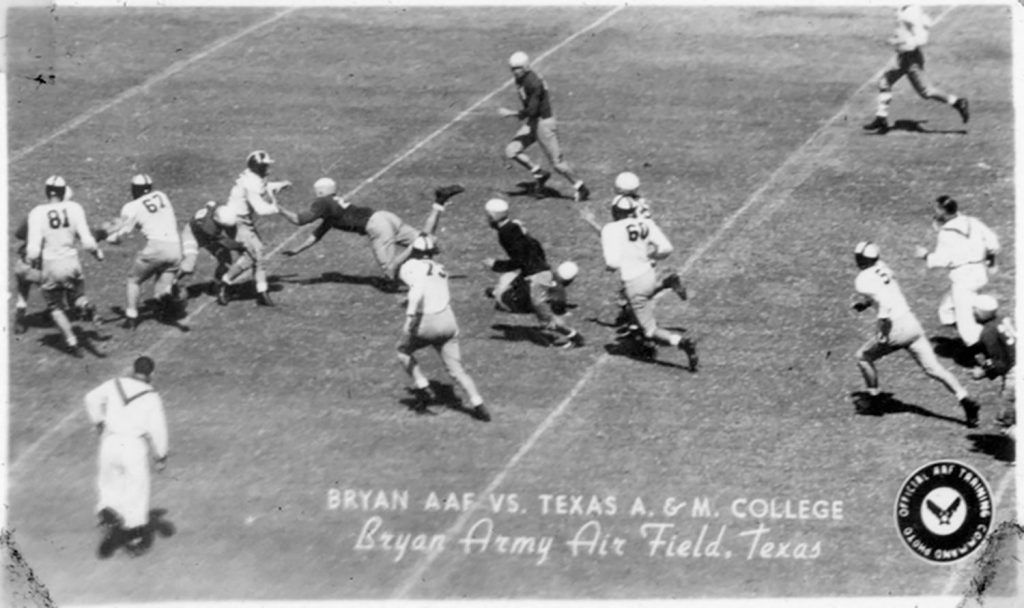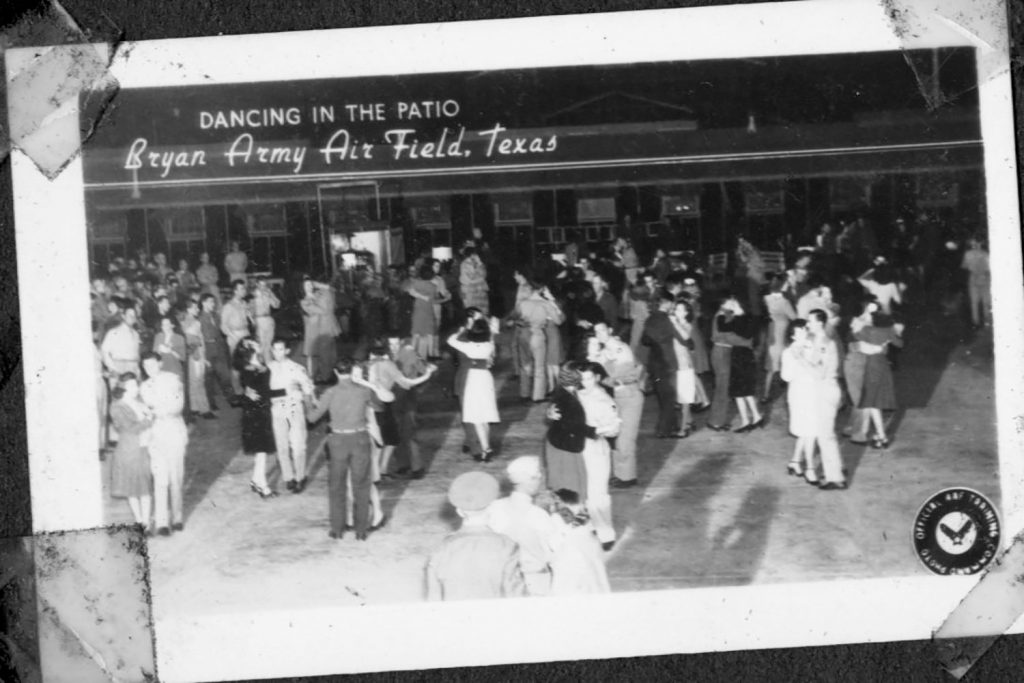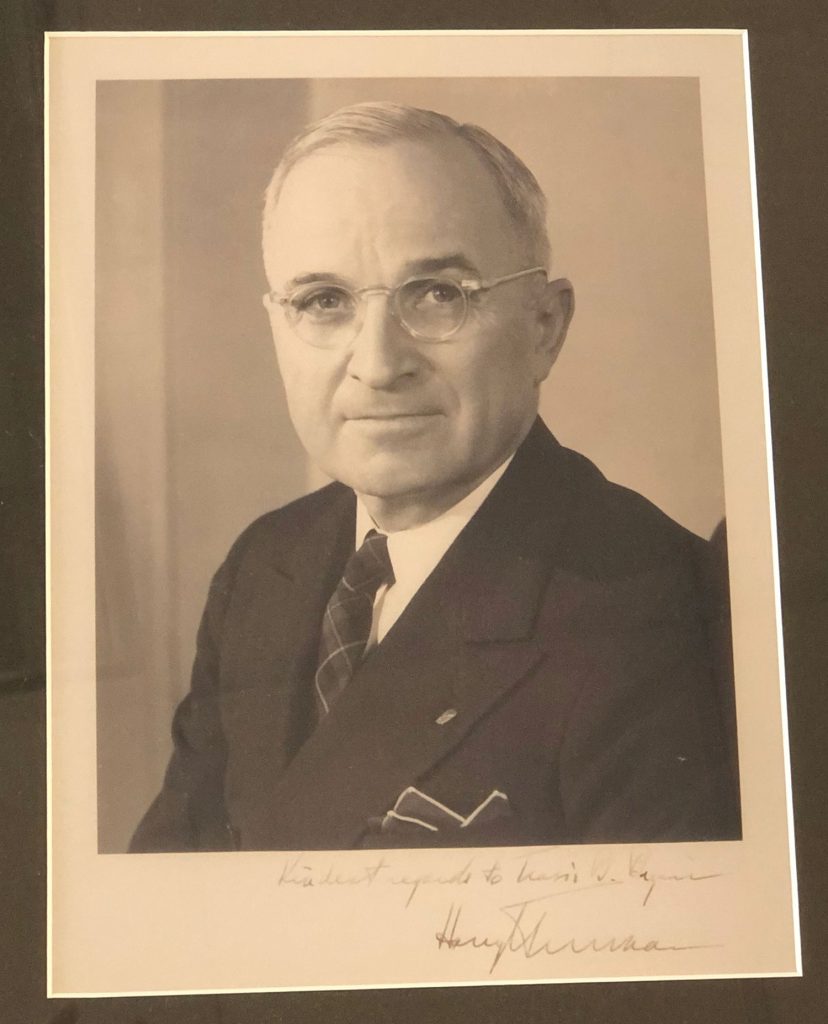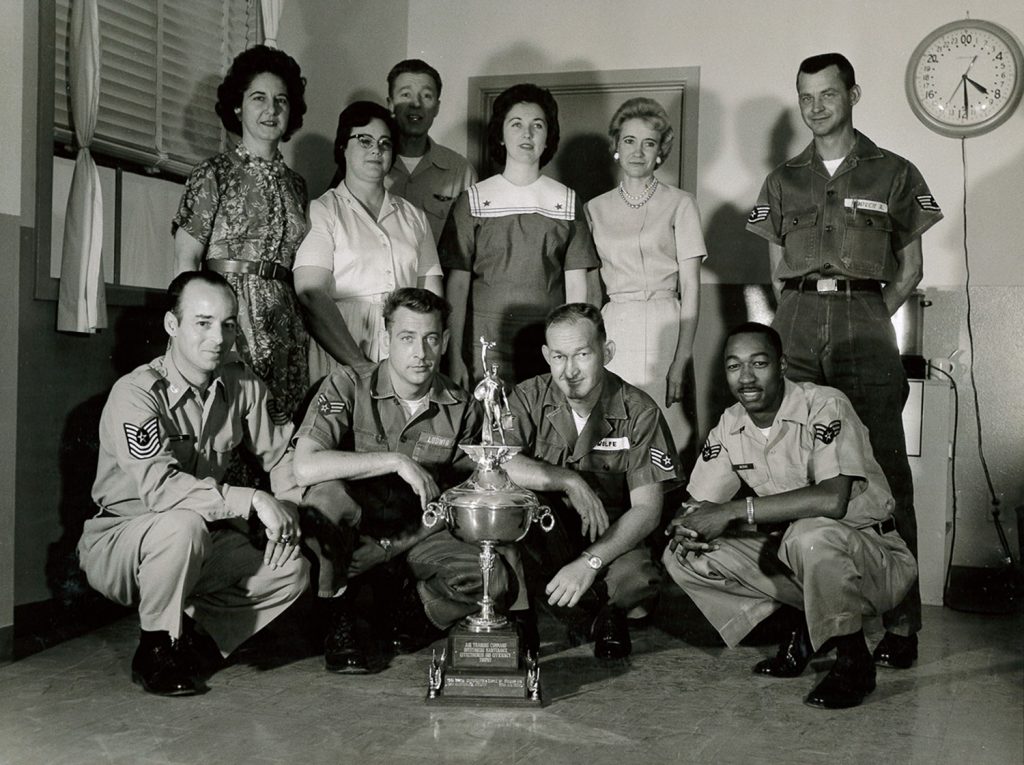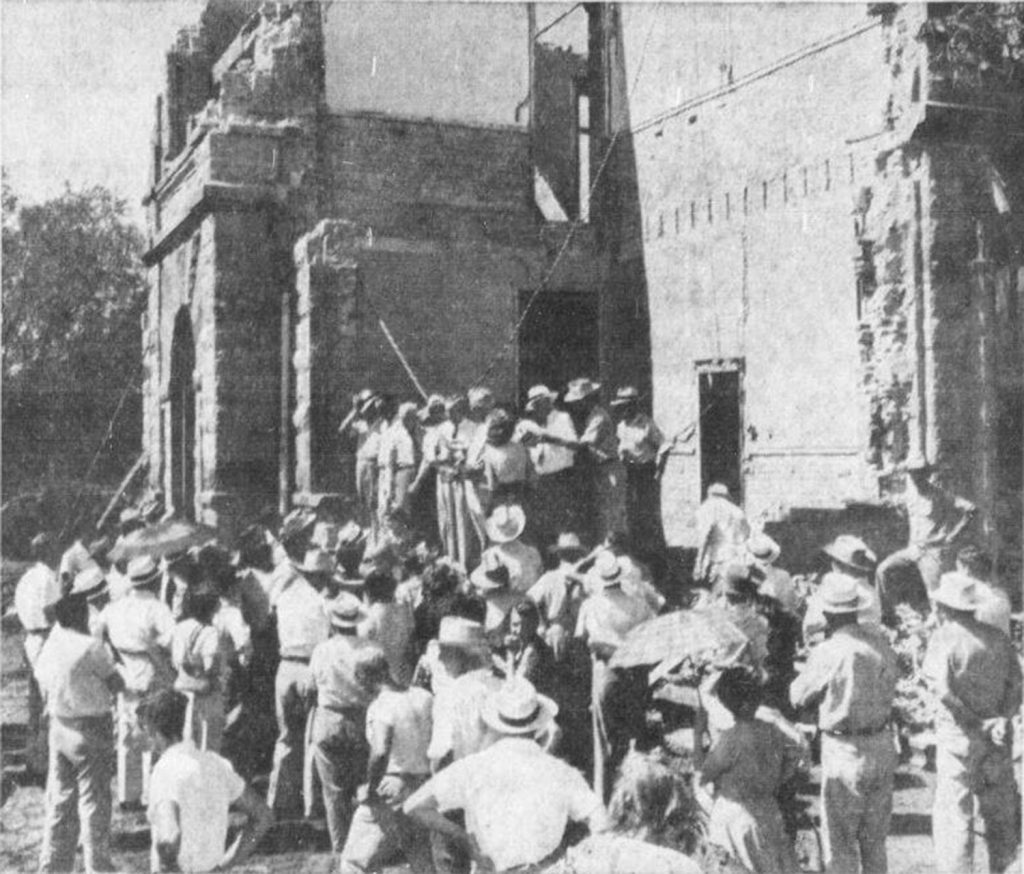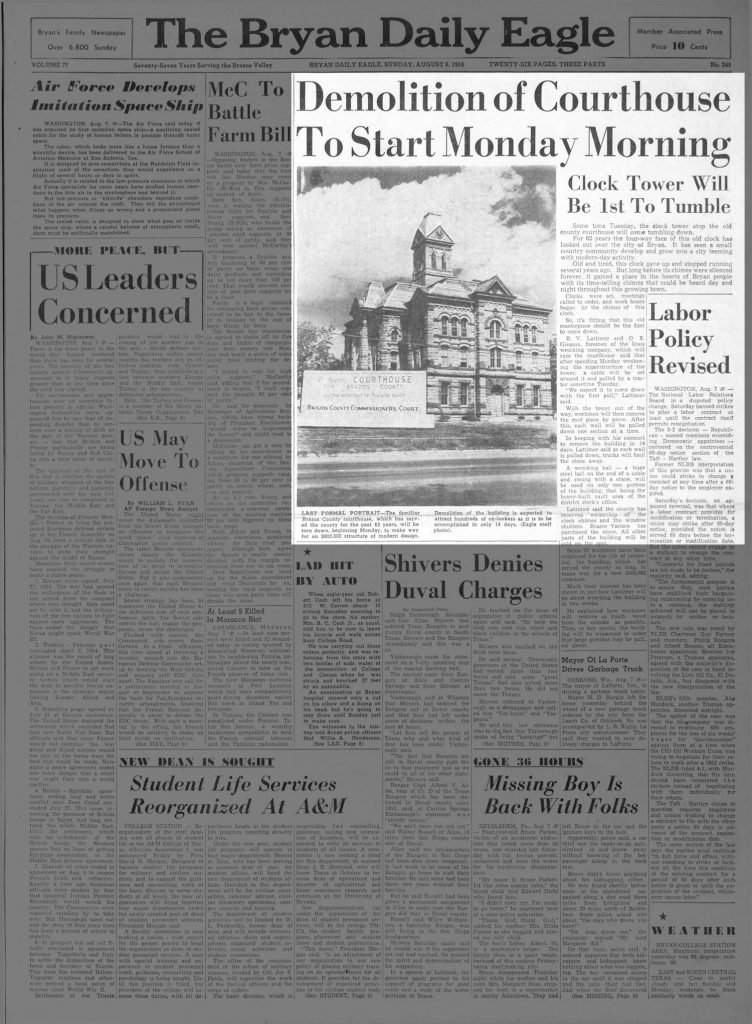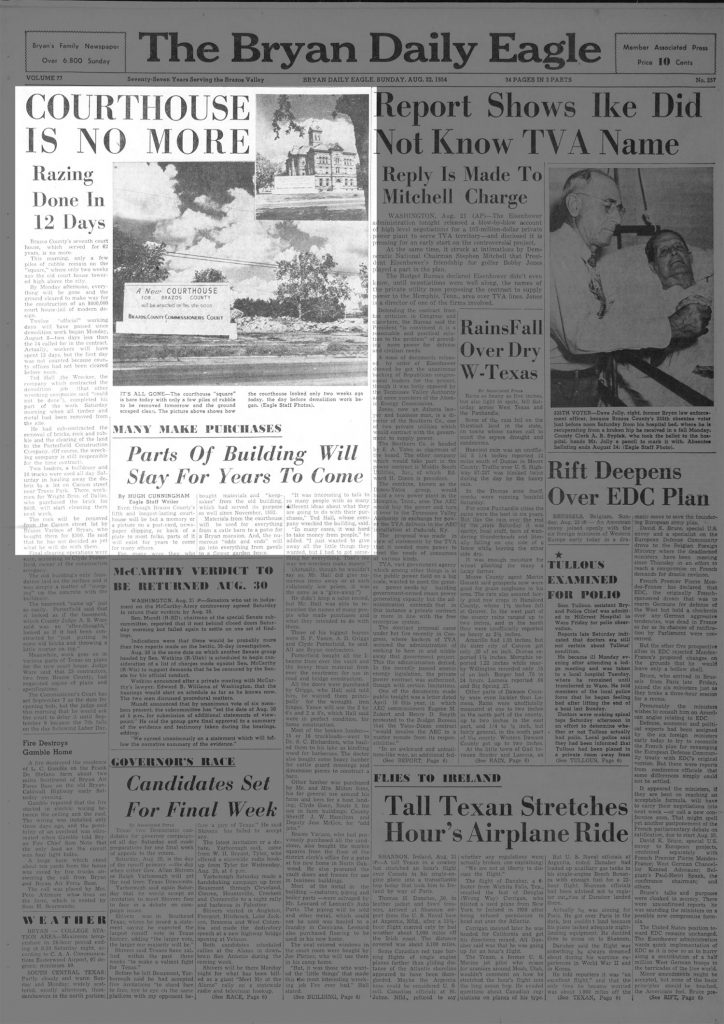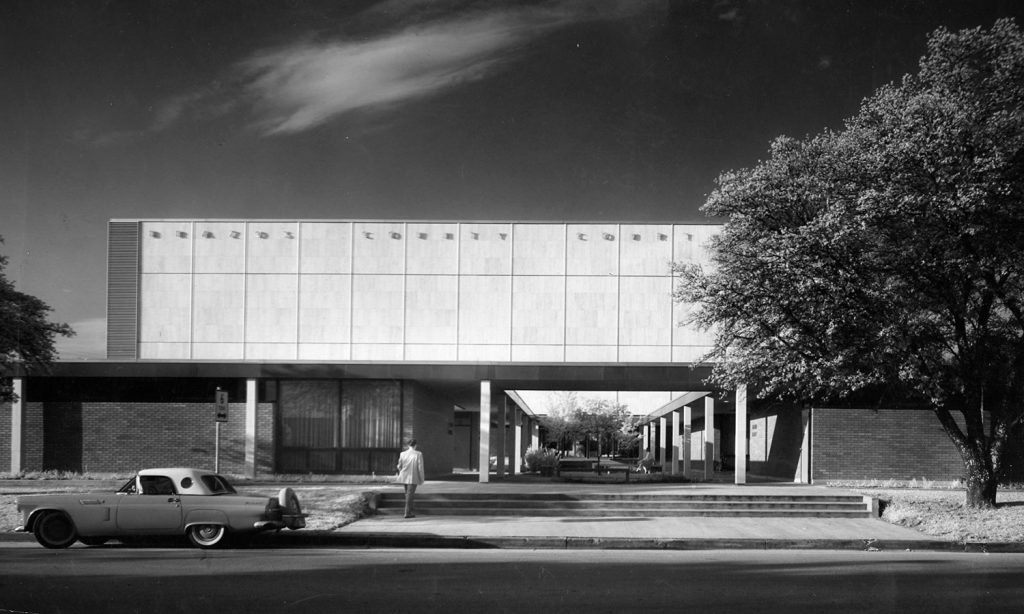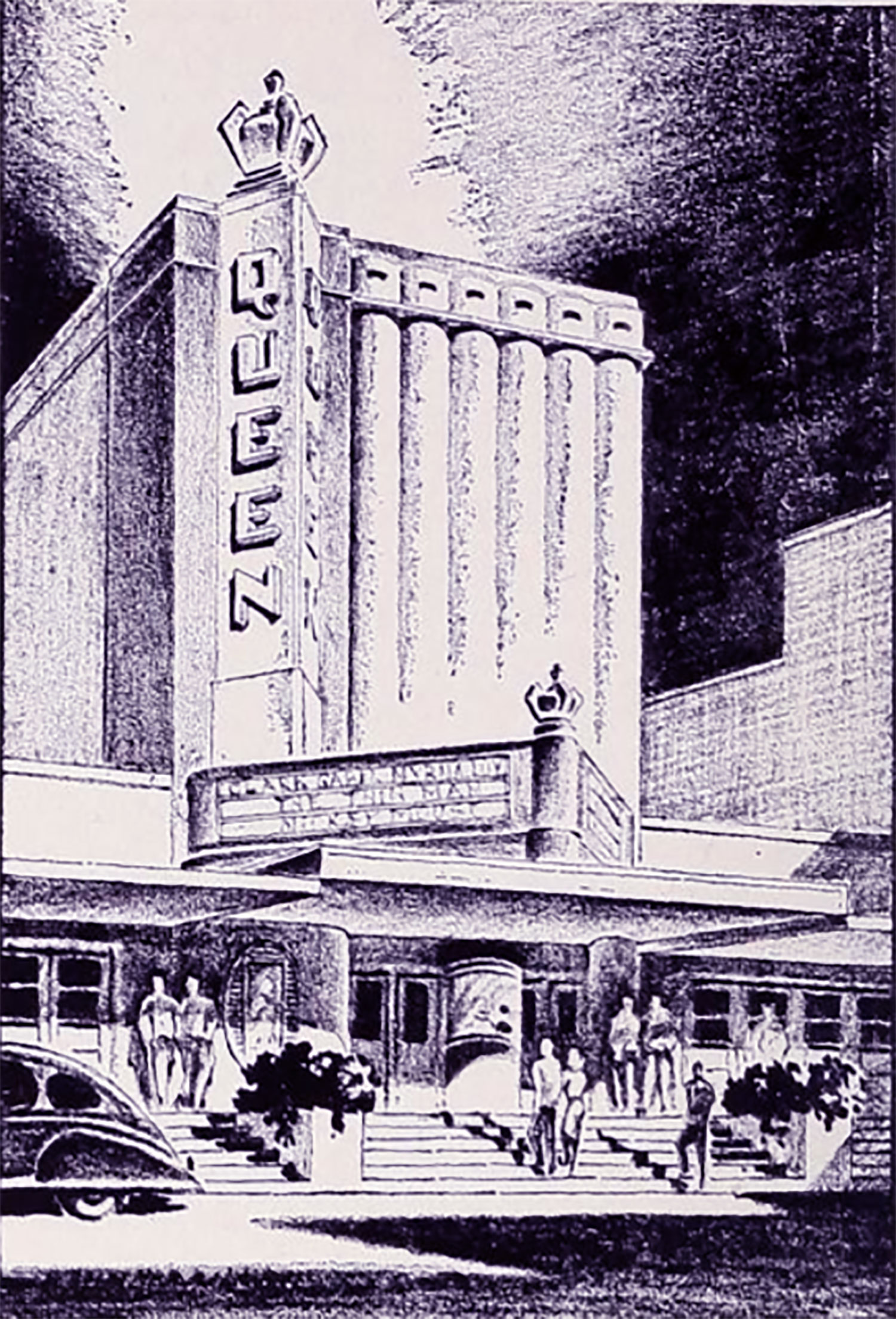
Depression, War and the Baby Boom
1931-1960
It’s known today as the era of “The Greatest Generation,” the decades when American men and women faced the two greatest challenges of the 20th century: the Great Depression and World War II. It’s an era that recalls the ideals of hard work, perseverance and personal sacrifice. And it’s the era when Bryan stopped being a small town and began to grow into the city we call home today.
1930s: The Great Depression
We were somewhat insulated: Bryan and Brazos County may have been insulated from the more extreme effects of the Great Depression. Listen to local historian Henry Mayo as he describes how being a predominantly rural and agricultural community helped.
Times were tough,
but daily life went on
The Great Depression was an economic tragedy of the highest magnitude. The book Brazos County History – Rich Past, Bright Future, from the Brazos County Heritage and History Council, calls it a “decade of despair” when referring to the impact on local businesses.
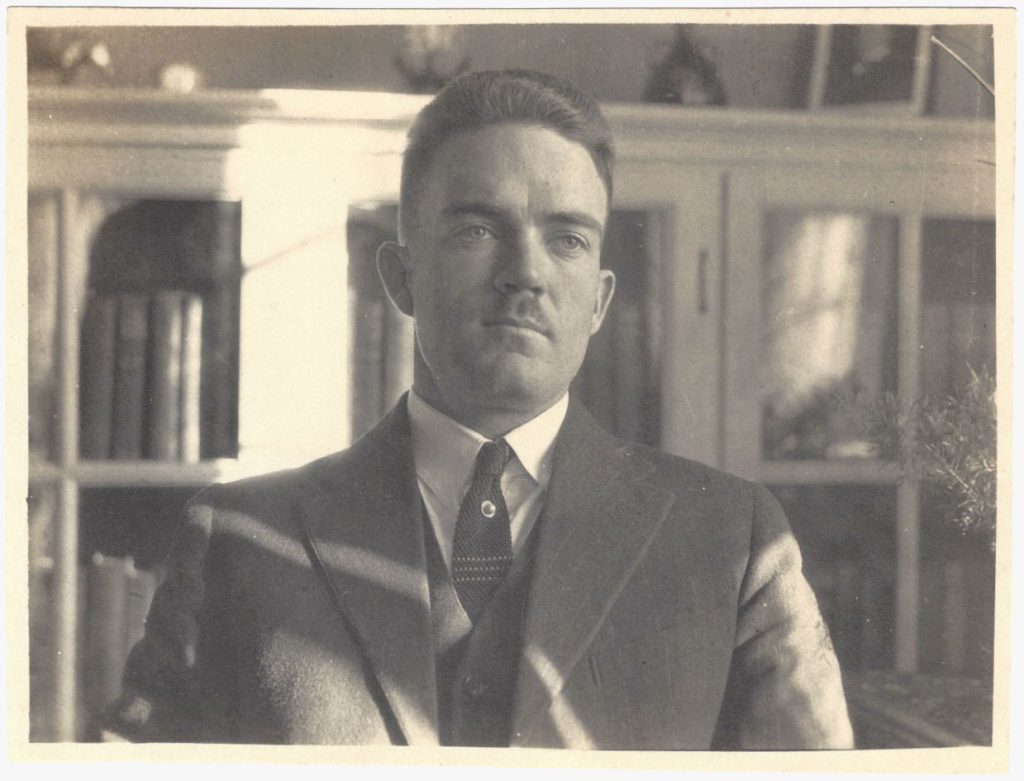
Aug. 23, 1931: Dr. L.O. Wilkerson opens Wilkerson Memorial Clinic in Downtown Bryan at the corner of Regent and 27th streets.
📷 Read more about Dr. Wilkerson and see his medical tools.
But it seems that Bryan was able to avoid some of the worst effects of the Depression because of its agricultural economic roots and because it was a smaller community that was removed from the larger manufacturing and corporate centers in the Northeast and Midwest. That’s not to say there wasn’t economic pain, only that the nature of the economy and labor in Bryan at the time, and the presence of Texas A&M, made the community a little less susceptible to the economic forces at work in other parts of the country.
One threat to local businesses, however, was the chain store. Bryan business leaders banded together in 1930 to protect their home turf from these large “foreign” interests from the distant lands of New York and Chicago. The Home Merchant’s Association, a group of local businesses, was formed to try and keep out the invading large retail stores. But this wasn’t a fight they were going to win. As Brazos County History recalls:
On the very same week that some of the vehement ‘anti-chain’ articles were appearing in the Eagle, Montgomery Ward placed a link in its chain in downtown Bryan.”
– Brazos County History – Rich Past, Bright Future, Page 437.
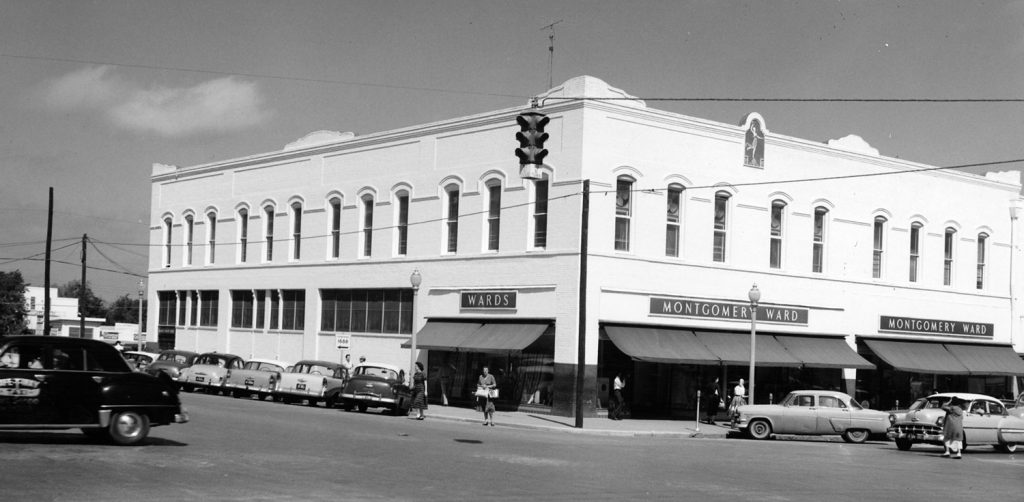
Another link in the chain: Montgomery Ward, seen in Downtown Bryan in the 1950s, established its store here in 1930, just as the Great Depression was taking hold.
Later in 1930, as the Depression got worse in Bryan, another organization of merchants called the Associated Community Builders was formed to encourage the community that good times were just ahead. Its promotions and ads often took a patriotic tone to try to lift people’s spirits and let them know that America was fighting back against the economic downturn.
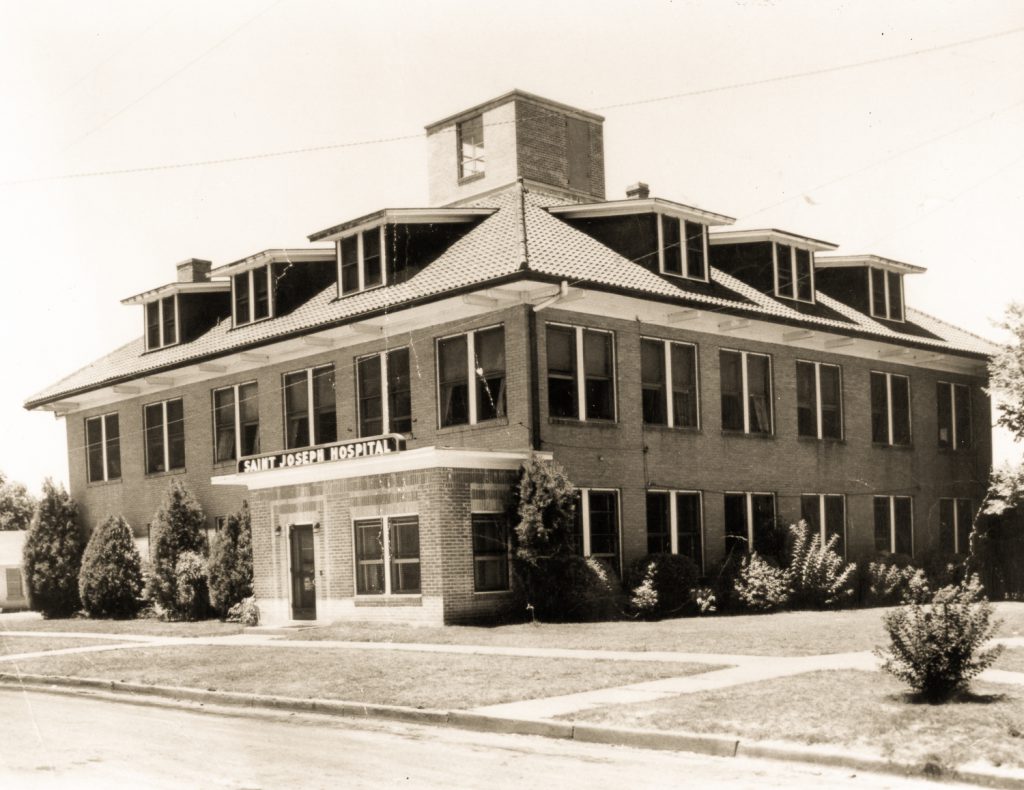
1935: Bryan Hospital is purchased by the Sisters of St. Francis and reopened as St. Joseph Hospital.
But the Great Depression wasn’t some small economic blip. It was here to stay. By the end of 1930 a community relief organization called the Good Cheer Association was collecting donations for those affected by the Depression. The Bryan Daily Eagle editorialized on Good Cheer’s behalf, noting that “many a youngster in Bryan is suffering” from lack of food and shelter.
And that’s pretty much how things were for several years. Franklin D. Roosevelt was elected president in 1932, and the New Deal programs started shortly thereafter in 1933 to help ease the effects of the Depression and get the country going again. Locally, a breakthrough came in 1936 with the completion of Highway 6 through Bryan. Growth had begun again, and by 1938, the City of Bryan broke its record for building permits in a single year.
1933: The Whitey Walker Gang robs Caldwell Jewelers in Downtown Bryan
From jewelry thieves
to the construction of Bryan’s crown jewel
The Great Depression was a difficult time, but that doesn’t mean life in Bryan was boring. In late 1933 and early 1934, Bryan witnessed a brazen act of crime, and the fallout, perpetrated by one of the era’s most infamous robber gangs.
1935: The site of Villa Maria Ursuline Academy is sold to Will Howell, who tore down the school and used the bricks to build two houses. In 1983, Paul Bonarrigo purchased the buildings and used the bricks to build the Messina Hof Winery visitor’s center, located on Old Reliance Road.
On Dec. 14, 1933, members of the Whitey Walker Gang robbed Caldwell Jewelers in Downtown Bryan and kidnapped John Sealy Caldwell and his wife, Celeste. The Caldwells were taken out into the country past Kurten, tied up and left there as the criminals made their escape.
It didn’t take long for the Caldwells to get free and make their way back to Bryan to report the robbery. Identifying the three men in mugshot books at the Houston Police Department, the Caldwells realized that they had encountered Whitey Walker, Blackie Thompson and Roy Johnson, three men who were known associates of other wanted criminals such as Bonnie and Clyde.
Associates of Bonnie and Clyde: Members of the Whitey Walker Gang – Whitey Walker, Blackie Thompson and Roy Johnson – were captured in Florida and returned to Bryan for trial. This created a need for increased security to prevent the Walker Gang’s associates, such as the Barrow Gang, from helping them escape.
In February 1934, the three criminals were caught in Florida and returned to Bryan for trial. They were also wanted for robbery and kidnapping in Palestine and Marlin. A spectacle of security surrounded Downtown Bryan during the trial as the community waited anxiously to see if other brazen criminal groups, such as the Barrow Gang, would come to town to try to help Walker and his associates escape.
In the end, the three men were convicted and were each sentenced to 99 years in the Texas Department of Corrections. They were sent to Walls Prison in Huntsville, “The Death House,” and would shortly thereafter make more history in the form of a daring prison break. Of the three, Thompson was the only one to actually make it over the wall and escape. Walker was shot and killed. Johnson was wounded and served the rest of his sentence in Oklahoma. That complete and amazing story is told in the book Over the Wall: The Men Behind the 1934 Death House Escape.
In 1938, Edna Schulman made a decision that would change the face of Downtown Bryan. It’s inconceivable that she could have predicted how the effects of that decision would continue to be felt today, 83 years later. That one decision created an icon.
Edna Schulman lost her husband, Morris, and both of his parents in the mid-1930s, but kept operating the Bryan Amusement Company and its theaters on Main Street. In 1938 she decided to invest heavily in a new, modern theater building for Bryan, just like the ones that were being built in large cities across the country.
She purchased the old hotel building that housed The Queen theater on the first floor, and contracted with a young and popular Dallas architectural firm, Pettigrew & Worley, to design a unique building to replace the old hotel. Pettigrew & Worley were becoming the go-to architects for theaters in Texas, and they were on the cutting edge with the latest in big-city architecture trends. As local historian Henry Mayo writes in his research paper, The Queen Theater: Bryan, Brazos County, Texas:
1938: The City of Bryan obtains a loan from the Rural Electric Administration to establish a rural electric division. Service territory is expanded to customers in Brazos, Burleson and Robertson counties. Approximately 800 miles of powerline is installed, and the rural division extends as far west as Tunis in Burleson County, and as far north as Wheelock in Robertson County.
1938: City of College Station is incorporated.
The Art Deco style was evolving into more aerodynamic designs, with curve forms and long lines, known as Streamline Moderne and Art Moderne. Architecture was in its heyday, with two world fairs underway in the United States simultaneously in 1939, each with many architecturally-significant buildings. Cars, trains and even household appliances were all being streamlined, as if they were expected to launch into orbit.”
– The Queen Theater: Bryan, Brazos County, Texas, Pages 6-7.
Modern monarch: An image of the original sketch of The Queen as drawn by architectural firm Pettigrew & Worley in 1939.
1938: Lightning strikes one of the towers of St. Andrews Episcopal Church. The damage is repaired with metal shingles saved from the original construction.
1938: The new Stephen F. Austin High School opens at 801 S. Ennis St. Designed by W.O. Sanders Jr., this Art Deco-style building served as a high school until 1971, when Bryan schools were fully integrated. It is now the administration building for Bryan ISD.
In June 1939, the old hotel was torn down, and construction of a magnificent new and modern theater began. The Queen Theatre that we know today as the defining symbol of Downtown Bryan was born.
And it wasn’t just modern in appearance. The latest construction techniques and trends were used, including steel columns and I-beams to support the large balcony, seating patterns to ensure that every plush upholstered chair was positioned with a clear view of the screen and, of course, air conditioning.
The Queen opened with much fanfare on Nov. 21, 1939, with a showing of the film Fifth Avenue Girl starring Ginger Rogers. The premiere event also featured a performance by the Texas A&M band, and many dignitaries were in attendance. It didn’t take long for news to spread about Bryan’s amazing new theater. Soon, The Queen had gained a reputation as one of the finest theaters in the Southwest.
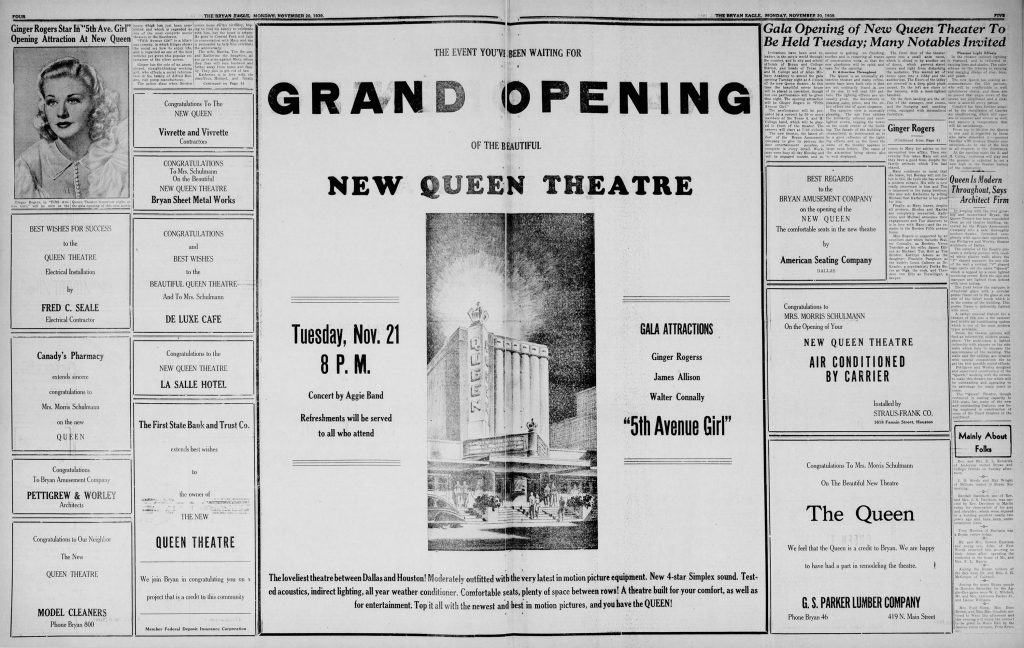
All hail The Queen: Pages 4 and 5 of the Nov. 20, 1939, edition of the Bryan Eagle are completely devoted to promoting the gala event and grand opening of the new Queen Theatre. This was a really big deal for Bryan.
From Country Club to city-owned: The story of Bryan Municipal Golf Course
The Bryan Country Club was not the first golf course in Bryan. That distinction goes to the Hill Crest Golf Links, which had a short lifespan in the mid-1910s. But in 1917 a group of local businessmen formed the members-only Bryan Country Club and set out to build a nine-hole golf course, swimming pool, clubhouse and lake at the corner of what is now S. College Avenue and W. Villa Maria Road.
Why is this important information? Because by 1939, the entirety of the Bryan Country Club would be owned by the City of Bryan.
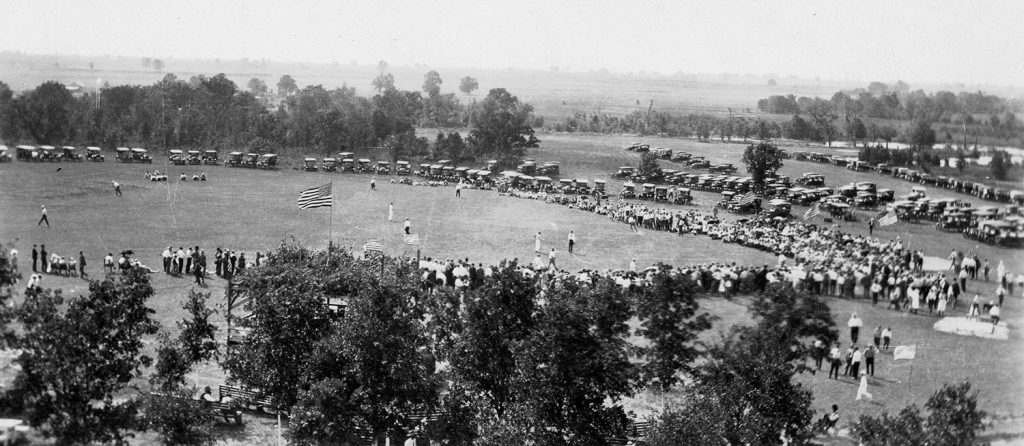
From private to public: In 1939, the City of Bryan was deeded ownership of the Country Club and began working on a full 18-hole golf course, calling it Bryan Municipal Golf Course. Today, the former golf course is being redeveloped into a world-class sports and entertainment park.
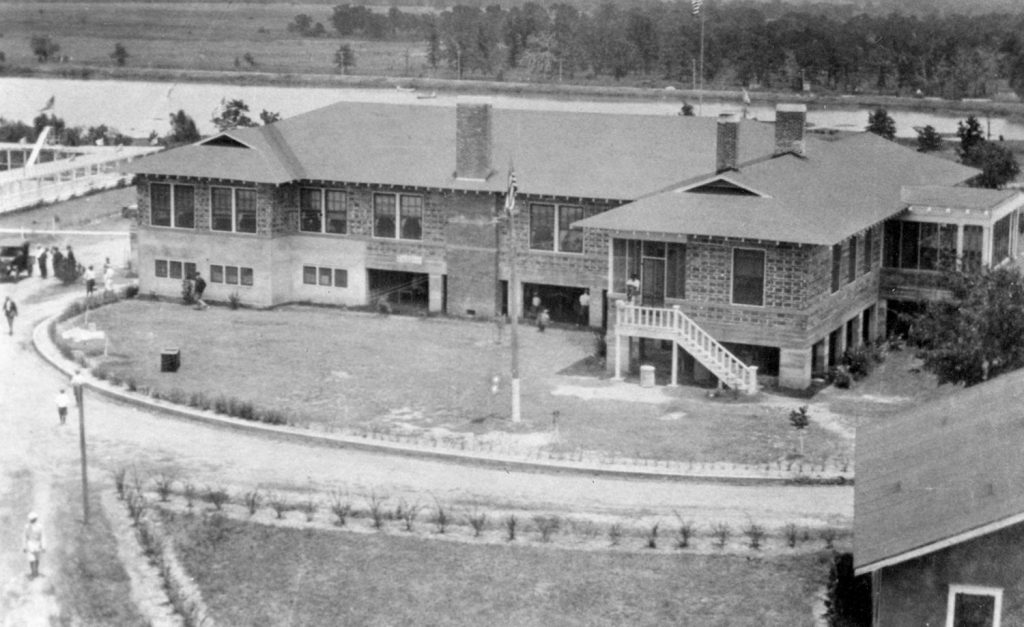
1938: W.J. Coulter donates land to the City of Bryan for the establishment of an airport. The city purchases additional land, and the 247-acre airfield is named Coulter Airfield.
📷 Read the acceptance document where the City of Bryan officially accepts Mr. Coulter’s land donation.
Jan. 1, 1940: Texas A&M defeats Tulane in the Sugar Bowl, 14-13. The Aggies finish the season a perfect 11-0 and win their first and only college football national championship.
In 1934, as the federal government created assistance programs to combat the Great Depression, the stockholders of the Bryan Country Club asked the City of Bryan to take over the property’s operation for a designated period of time. A new water pipeline to the swimming pool was needed, and by having the city manage the property, it was eligible for federal assistance from the Emergency Relief Administration.
So, the Bryan Country Club became the “Municipal Playground” in 1934, and the city began its long-term relationship with the property. But it wasn’t until 1939 that the City of Bryan officially took ownership of the property.
The Bryan Country Club had outstanding mortgage debts of more than $28,000, and the City of Bryan purchased the lien notes from the club’s lien holder. Rather than having the city foreclose on the Country Club, the club transferred the deed to the property to the City of Bryan in payment of the outstanding debts.
The city then began the process of expanding the golf course from nine to 18 holes, and thus what would become known as Bryan Municipal Golf Course came into being.
Nov. 1, 1940: Santa Teresa Catholic Church is established
First church for the Hispanic Catholic Community: Listen to longtime church members Helen and Oscar Chavarria as they discuss the early days of Santa Teresa Catholic Church.
Santa Teresa’s roots began with a traveling priest, Father Frank D. Urbanosky, known as Padre Panchito, and his Espiritu Santo Mission on wheels.
1930s-1950s: Hispanic and African American education
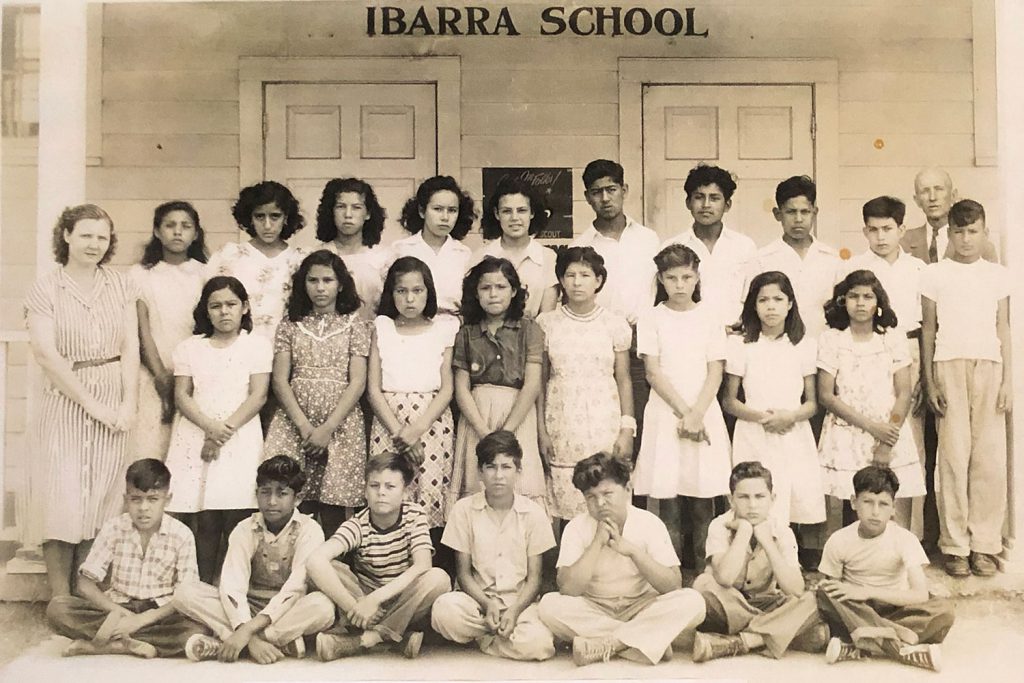
Ibarra School and E.A. Kemp Junior-Senior High School: Ibarra School served Hispanic students from the 1930s until the early 1950s. E.A. Kemp served African American students at the middle and high school levels from 1930 to 1960.
Life at Ibarra: Helen and Oscar Chavarria both attended Ibarra School. In fact, in the photo above of the 1947-48 fourth-grade class, Helen is third from the right in the second row.
The Kemp experience: Listen to Dr. Oswell Person describe the strength of the bond that E.A. Kemp graduates share.
Read the transcript about E. A. Kemp graduates (opens in a new window)
The fact that we were segregated. The fact that we had in common this one school. … If you lived in Bryan from the 1940s forward, to the point in which the schools merged and were desegregated, you met at E.A. Kemp High at some point in your life. You had that experience.”
– Dr. Oswell Person, E.A. Kemp graduate and author of African American Bryan, Texas: Celebrating the Past.
Elementary education, split three ways
When people talk about segregated schools in the 20th century, most of the time they are referencing the split between schools serving African American students and schools serving white students. But in Bryan beginning in the 1930s, there was also another split: Hispanic students.
From the mid-1930s to the early 1950s, Ibarra School on the west side of Bryan served as the primary school for Hispanic children. While it’s not clear that Ibarra was intended to be a segregated school, that was the de facto result since it was built in an area where only Hispanic students were within walking distance to attend.
But there was another uniqueness about Ibarra. It served students only through the fifth grade. After that, students had to go to a different school – in most cases Bowie Elementary for one year – before entering junior high. So, while Ibarra was de facto segregated, Hispanic students were not completely segregated at all age groups, like African American students were.
Bryan and A&M face
a world at war, again
By 1939 the world was at war once more. And while World War I had been a tragedy of epic proportions, the truly global scope of this new war and its atrocities would turn the entire world upside down.
1941-1945: According to the Texas A&M Corps of Cadets guidebook, more Aggies served as officers in World War II than any other school, “including the combined totals of the United States Military Academy and United States Naval Academy.”
The book Texas Aggies Go to War by Henry Dethloff lists the names of 854 Aggies who died in World War II. And seven Aggies were awarded the Medal of Honor.
Estimates vary, but as many as 60 million people may have died in World War II, the majority civilians. Nearly every country in Europe had been invaded and many laid waste by the end of the fighting. And with the dropping of the atomic bombs on Hiroshima and Nagasaki, Japan, the world entered the nuclear age. The global balance of power would be changed for the next 45 years as the United States and the Soviet Union took on the roles of “superpowers.”
As they had decades before, the people of Bryan, and the students and former students of Texas A&M, heeded the call to arms and served proudly in this global conflict. About 20,000 A&M students and former students fought in World War II, with around 14,000 of them serving as officers.

Bryan Army Air Field opens in 1943: Bryan Army Air Field was established as a pilot training school. Every pilot and plane had to have a support staff, such as the mechanics shown above in 1943. The base also fielded a football team in 1943 and 1944. In both seasons, the Army Air Field players (in dark jerseys) faced Texas A&M, and it didn’t go well for them either time. They were beaten 48-6 in 1943 and 39-0 in 1944.
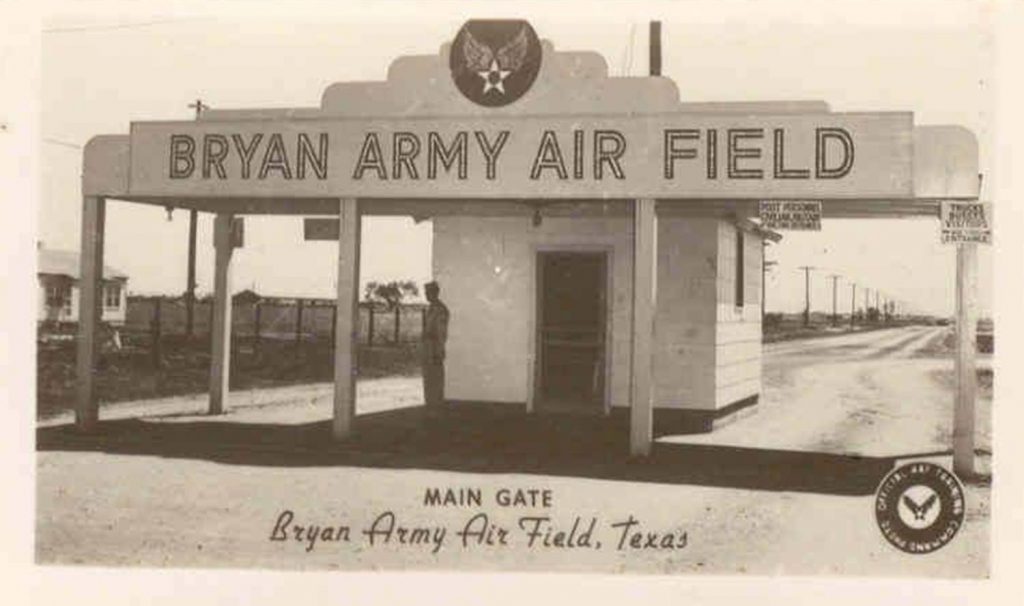
1946-1949: The deactivated Bryan Army Air Field is used as the Texas A&M Annex for freshmen. Facilities are leased at the air field to house both returning veterans and incoming Corps freshman classes.
1947: Former teacher Lucy Harrison, at left in the photo below, is the first woman to serve on the Bryan City Council. Harrison served from 1947-1949.
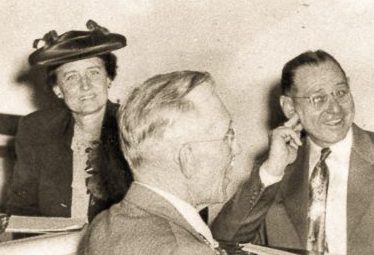
On the home front, while many locals were leaving to fight, many more people were arriving in Bryan for their military training. The president of First National Bank, Travis B. Bryan, played a leading role in the home-front war effort and was instrumental in the selection of Bryan as the location for a pilot-training facility for the Army Air Forces.
In 1943, Bryan Army Air Field was opened, and in an official dedication ceremony on June 6, 1943, Travis B. Bryan presented a P-51 Mustang fighter plane to the base’s commander, Col. Joseph Duckworth. The $50,000 plane was named “The Spirit of Bryan Field” and had been paid for by the citizens of Bryan through a community fundraising drive led by, who else, Travis B. Bryan.
For two and a half years, the Bryan Army Air Field was an economic catalyst, pumping more than $9 million into the local economy. As the war ended in 1945, the need for the base was nullified, and it was soon deactivated. But its story would continue in just a few short years.
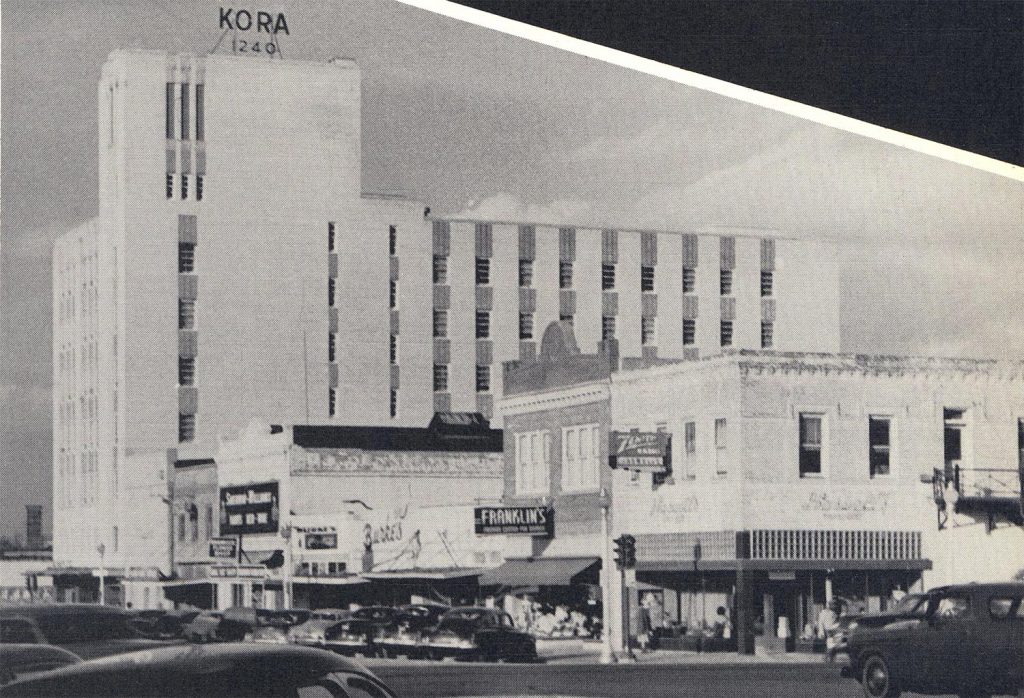
1948-1949: The Varisco Building is developed by Biagio “Brazos” Varisco, a notable agriculturalist and developer. Varisco was born in Poggioreale, Trapani, Italy, in 1902 and immigrated to the United States in 1907.
🎧 Listen to Norris Jay Pritchard Sr. share a story about the building of the Varisco Building and how it caused a really big problem for the building next door.
Air Force base: Part 2,
a new courthouse and a population explosion
In 1951, as hostilities on the Korean Peninsula escalated, the Bryan Army Air Field, now called the Bryan Air Force Base, was reactivated to again serve as a pilot-training facility. Despite the reasons for its reactivation, having the air base reopened was a boon for Bryan’s economy. Bryan had lost out to Colorado Springs, Colo., in a bid to land the new Air Force Academy when the air forces became their own military branch in 1947.

Take two: The Bryan Air Force Base was reactivated in 1951. Keeping jets like the one seen here in top shape took a lot of work, and apparently the servicemen and support staff were good at it. Here they pose with the Air Training Command Outstanding Maintenance Effectiveness and Efficiency Trophy.
Travis B. Bryan had connections with many politicians in Washington, and during the war and postwar years, he and President Harry S. Truman became friends.
It has been reported that President Harry S. Truman personally called Travis B. Bryan to give him the news that the air base would be reactivated, as the two men had become friends in the previous years. Bryan himself was well acquainted with many politicians in Washington and Austin.
The base would remain active during the 1950s but would be deemed surplus to requirements at the end of the decade. In 1959 it was announced that the base would be phased out, and it officially closed in 1962.
1954: Demolition of the Brazos County Courthouse
Tearing down an icon: Listen to local historian Henry Mayo discuss how the Brazos County Courthouse was demolished by manual labor and what the building meant to older residents at the time.
📷 View a piece of the sandstone from the 1892 Courthouse.
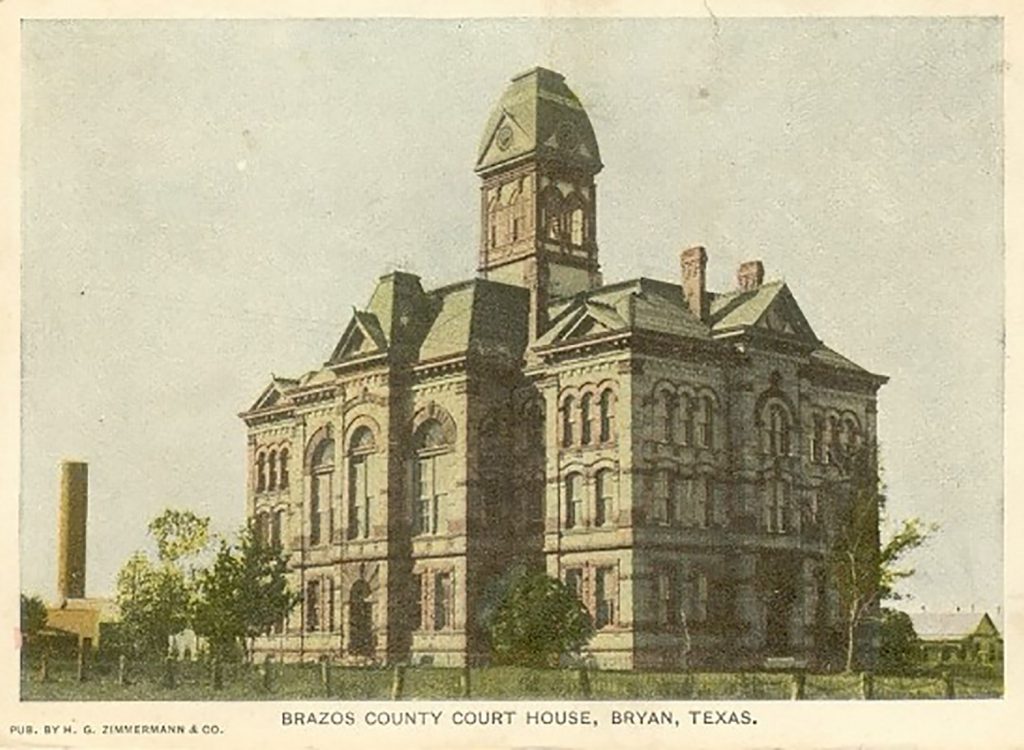
1954: A new wing is added to St. Joseph Hospital.
1955: Elvis Presley performs in Bryan.
May 22, 1957: KBTX-TV, the Brazos Valley’s first television station, begins broadcasting from a four-room brick building on E. 29th Street.
The 1892 courthouse was not the first Brazos County Courthouse, nor the second, nor even the third or fourth. But it had stood longer than all of the others combined, and it was an iconic structure in Downtown Bryan, with its sandstone exterior and its four-sided clock tower looming over the city.
But in 1954, the decision was made that the county needed a newer, modern courthouse, and the landmark was razed to the ground. That in itself would be sad, but not terribly interesting. It’s the way the building was demolished, however, that is somewhat unbelievable.
The winning bid for the contract was from a wrecking firm in Des Moines, Iowa, headed by a gentleman named Ted Hall. Hall actually submitted two bids. One that was the cheapest, and one that stipulated that the demolition could be completed in 14 days for $1,280 more. That was a much shorter timeframe than any of the other bids, the next closest being 30 days.
Twelve days is all it took: More than 60 years of history came down in less than two weeks.
In many cases it was hard to take money from people. I just wanted to give away all the little things they wanted, but I had to get something for everything. That’s the way we wreckers make money.”
– Ted Hall, as quoted in the Bryan Daily Eagle, Aug. 22, 1954.
Hall’s company used some other subcontractors, but primarily the old courthouse was demolished with locally hired manual labor and sledgehammers. Hall’s firm was also responsible for getting rid of the interior items from the courthouse.
The site of the demolished courthouse was cleared to make room for the present-day Brazos County Courthouse, which was built in a very modern style for the time period. The new building was completed and opened in 1957, and historical markers preserving the memory of the 1892 courthouse stand in the building’s south courtyard.
Throughout the 1950s, changes and modernization occurred in Bryan in many areas, but as the decade came to a close, two major social realities stood out. One: Institutionalized segregation’s days were numbered. And two: Bryan had grown a lot!
With the Supreme Court’s verdict in the landmark 1954 Brown v. Board of Education of Topeka case, segregation took its first major hit. And though it would take many years, and many other lawsuits, to end institutional segregation, times were changing in the late 1950s in Bryan. And while Bryan schools weren’t integrated until 1971, and racism and discrimination continue in some segments of society even today, in the late 1950s progress was being made. Perhaps they were only baby steps, but they were still steps in the right direction.
1950s: Progress amid segregation
A Hispanic perspective: Helen and Oscar Chavarria discuss their experiences with segregation and prejudice growing up in Bryan.
An African American perspective: Listen as Sunny Nash talks about segregation when she was growing up in the 1950s in Bryan. During this 2012 interview, she was asked if there were any places in Bryan that broke the barrier at that time.
Read the transcript of Ms. Nash’s story (opens in new window)
We couldn’t come to the library because it was segregated. Margaret read all the books that the bookmobile had … so she said: I’m going to go to the Carnegie Library.”
– Sunny Nash, in a 2012 interview with Anne Preston, oral historian for the Carnegie History Center.
1958: A new trend in commercial expansion begins as Townshire Center, at the corner of Texas and Avondale avenues in south Bryan, becomes Bryan’s first major shopping center.
1959: J.C. Jaques buys the LaSalle Hotel and converts it into a nursing home.
When the census was taken in 1960, the results were staggering. Bryan had a population of 27,542. That doesn’t seem large today, but it was a big jump at that time, considering that the 1950 population was only 18,102.
Much of that population increase can probably be attributed to the post-World War II baby boom, but some of it can also probably be attributed to the presence of the Bryan Air Force Base and a growing Texas A&M University.
In 1960, at the end of the “Greatest Generation” era, Bryan’s population was more than 3 1/2 times the size it was in 1930. And growth was not going to slow down. But as Bryan and Texas A&M kept getting bigger, the city’s residential and commercial footprint expanded farther and farther outside of the traditional downtown area, most notably southward toward the university. This created a whole set of new challenges – challenges that would take decades to overcome. The decline of Downtown Bryan was on the horizon.

